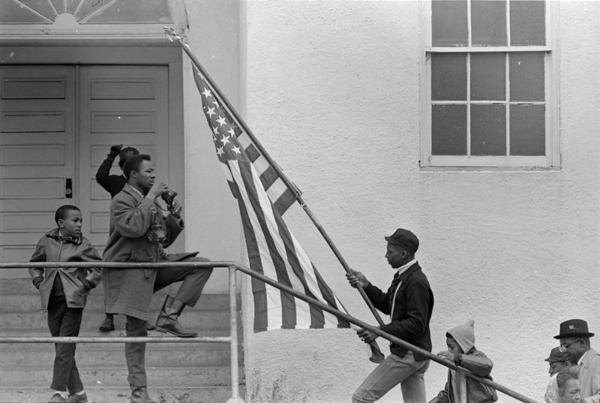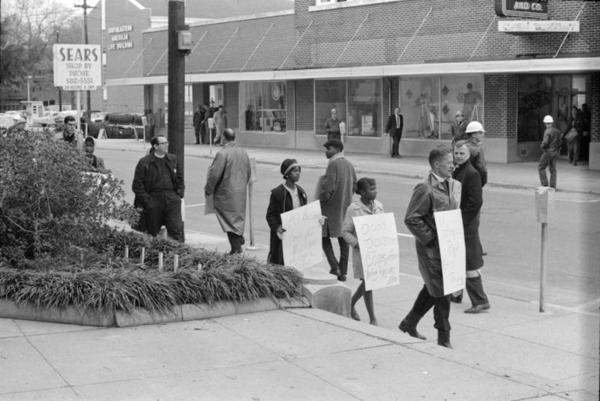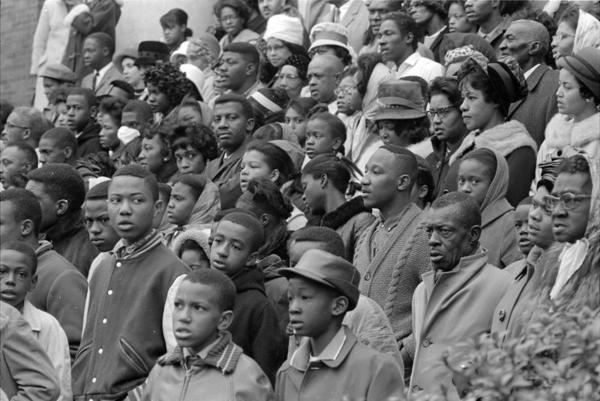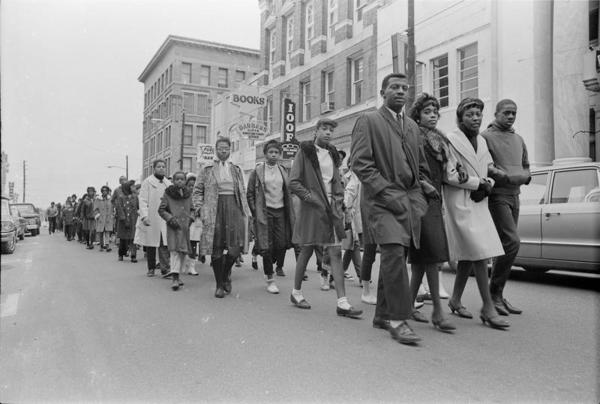In Honor of Youth Protest
In honor of the activism of many children and teenagers across the nation, we share two entries from The Mississippi Encyclopedia, one on the Children’s Crusade of Jackson, by historian Daphne Chamberlain, and another on activist Brenda Travis, by Ted Ownby. All photos are from the Moncrief Photograph Collection at the Mississippi Department of Archives and History and document activism in Hattiesburg.
In honor of Youth Protest in Mississippi

Children’s Crusade
Discontentment with life in a segregated society gave impetus to youth activism in Jackson during the civil rights era. In response to the perceived need for social change, African American children between the ages of seven and eighteen combined forces with community leaders and civil rights workers to challenge Jim Crow in Mississippi’s capital city.
Organized political engagement for social change was evident among Jackson youth as early as 1957, when one of two Mississippi chapters of the National Association for the Advancement of Colored People (NAACP) Youth Council was established in Jackson. The West Jackson Youth Council sought primarily to educate young people on voter rights. By 1960 the city also had a North Jackson Youth Council as well as collegiate chapters of the NAACP.

The Jackson Youth Councils became a powerful force in mobilizing the city’s African American community for social change. The children encouraged African Americans in Jackson to vote; to apply for respectable jobs, especially in white-owned establishments; and to boycott segregated events and public facilities. As the Youth Councils’ involvement increased, so did their membership. The Jackson movement intensified, with members of the Youth Councils conducting freedom workshops and surveys, distributing leaflets, and recruiting more members.
Between 1960 and 1962, youth activists encouraged blacks to boycott downtown Jackson businesses, particularly during the Easter and Christmas holidays, and to stay off Capitol Street. As part of this effort, college and high school students conducted house-to-house canvasses of the sixty-one thousand blacks in the Jackson area.
Jackson’s Youth Councils continued their efforts to dismantle the capital city’s system of segregation by attempting to integrate city parks and pools. Young people also tested the city bus lines by sitting on seats reserved for whites only. The Jackson Zoo and the Mississippi State Fair also became targets for civil rights protests.
Children’s participation in the Jackson movement reached its height in the spring of 1963. In late April, Mayor Allen C. Thompson met with African American leaders and acquiesced to most of their demands, but he later denied having made any agreement. In response to officials’ refusal to negotiate, youth orchestrated Jackson’s first mass demonstration of the freedom struggle in late May. Demonstrations, marches, and sit-ins took place in the downtown area, and youth activism influenced other civil rights organizations to take a more active role in the Jackson movement.

On 30 May 1963 Jackson youth organized a crusade for equality. Many participants were students from Lanier, Jim Hill, Brinkley, and Holy Ghost Catholic High Schools. As they marched, the children carried American flags, chanted “We want freedom!” and sang freedom songs. Jackson city police officers, sheriff’s deputies, and state highway patrolmen were on hand to arrest the young demonstrators—more than a thousand over a two-week period. The vast number of children arrested forced the conversion of the state fairgrounds into a temporary jail, which many activists referred to as a concentration camp.
In the fall of 1965 the Jackson Youth Council of the NAACP organized the Jackson Youth Movement, which continued boycotting and demonstrating. Jackson’s young people remained significant agents of change in the civil rights movement until 1967.
Daphne R. Chamberlain, Tougaloo College
Daphne Rochelle Chamberlain, “‘And a Child Shall Lead the Way’: Children’s Participation in the Jackson, Mississippi, Black Freedom Struggle, 1946–1970” (PhD dissertation, University of Mississippi, 2009); Mississippi History Now website, http://mshistorynow.mdah.state.ms.us; John Dittmer, Local People: The Struggle for Civil Rights in Mississippi (1995); Myrlie Evers-Williams and Manning Marable, eds., The Autobiography of Medgar Evers: A Hero’s Life and Legacy Revealed through His Writings, Letters, and Speeches (2005); John R. Salter, Jackson, Mississippi: An American Chronicle of Struggle and Schism (1979).
Brenda Travis
(b. 1945) Activist
A teenaged civil rights activist, Brenda Travis dramatized both the demands for change and some of the tensions within the civil rights movement. McComb, Mississippi, was one of the first locations where activists from the National Association for the Advancement of Colored People (NAACP) and those from the Student Nonviolent Coordinating Committee (SNCC) worked together, and members of the two groups sometimes came into conflict over methods and rhetoric. Some SNCC activists, especially Marion Barry, favored direct-action strategies in opposition to racial segregation, while some NAACP activists wanted to continue to work through legal channels and to concentrate most of their efforts on voter registration.
Born in 1945, Brenda Travis was the fourth of seven children of sharecropper L. S. Travis and his wife, Icie Martin Travis. When she was ten, local police burst into the house one night and arrested her thirteen-year-old brother without telling the family what he had allegedly done. The incident occurred around the time of Emmett Till’s murder, and when Travis saw pictures of Till’s beaten body, “I became enraged and knew that one day I had to take a stand.” That day came in August 1961, when the fifteen-year-old girl and two other protesters were arrested for participating in a sit-in at the whites-only section of McComb’s Greyhound bus station. She was held in the Pike County Jail for a month, and upon her release she and another classmate who had been arrested, Ike Lewis, were expelled from Burglund High School. On 4 October 1961 more than a hundred Burglund students staged a protest against their classmates’ expulsion and the murder of Amite County voting rights activist Herbert Lee on 25 September. SNCC workers joined the students, who congregated on the steps of McComb’s City Hall to pray. When the protesters refused to leave, they were arrested and charged with disturbing the peace; all those who were over age eighteen also faced charges of contributing to the delinquency of minors. The SNCC workers were beaten by police while FBI agents took notes, and Travis, who was on probation, received an indeterminate sentence in a juvenile detention center in Oakley. After the march to City Hall, Burglund High’s principal asked students to pledge not to participate in demonstrations and demanded that they return to school or be expelled. On 16 October 1961 more than one hundred students arrived at the school to turn in their books. SNCC workers then opened the Nonviolent High of Pike County, where the students took classes until the SNCC workers were tried, convicted, and jailed for several months. Many African Americans in McComb, including a number who were working with the NAACP, were displeased that the SNCC was allowing teenagers to face violence and arrest.
In the summer of 1962, after more than six months at Oakley, Travis was released into the custody of a professor from Talladega College, an African American school in Alabama. Mississippi governor Ross Barnett had agreed to release the girl on condition that the professor take her out of Mississippi within twenty-four hours. He took her back to Talladega, but after he became abusive, Travis fled to Atlanta, where SNCC executive director James Forman and his wife took her in. That fall, Ella Baker helped Travis enroll at the Palmer Memorial Institute, near Sedalia, North Carolina. After a year there, she moved to Connecticut, where she graduated from high school. She returned to Mississippi in 1964 out of “defiance” but felt unsafe and soon left. She worked briefly with Rev. Jesse Jackson in Chicago before settling in California in 1966 and attending business college and becoming involved in community organizations.
In October 2011, during a commemoration of the fiftieth anniversary of the student walkout, the McComb school district awarded honorary diplomas to Travis and other students suspended because of the protests. In 2013 she founded the Brenda Travis Historical Education Foundation to bring youth leadership and community development training opportunities to McComb.
Ted Ownby, University of Mississippi
Raymond Arsenault, Freedom Riders: 1961 and the Struggle for Racial Justice (2006); Brenda Travis Historical Education Foundation website, www.brendatravisfoundation.org; Clayborne Carson, In Struggle: SNCC and the Black Awakening of the 1960s (1981); John Dittmer, Local People: The Struggle for Civil Rights in Mississippi (1994); McComb Legacies website, www.mccomblegacies.org; Charles M. Payne, I’ve Got the Light of Freedom: The Organizing Tradition and the Mississippi Freedom Struggle (1995); Brenda Travis interview (February 2007), http://www.crmvet.org/nars/travisb.htm.

